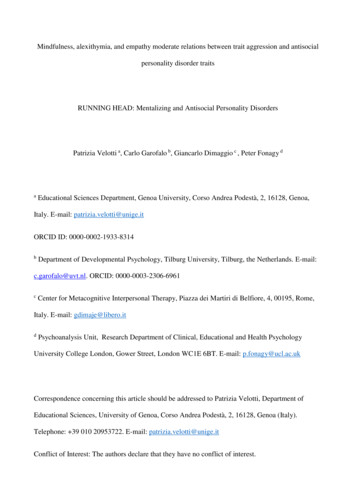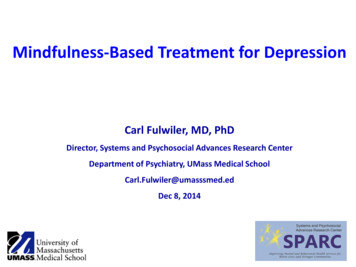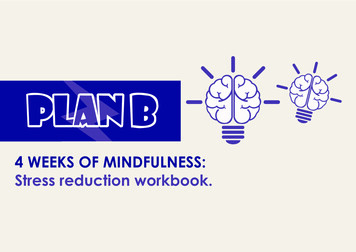
Transcription
Mindfulness, alexithymia, and empathy moderate relations between trait aggression and antisocialpersonality disorder traitsRUNNING HEAD: Mentalizing and Antisocial Personality DisordersPatrizia Velotti a, Carlo Garofalo b, Giancarlo Dimaggio c , Peter Fonagy daEducational Sciences Department, Genoa University, Corso Andrea Podestà, 2, 16128, Genoa,Italy. E-mail: patrizia.velotti@unige.itORCID ID: 0000-0002-1933-8314bDepartment of Developmental Psychology, Tilburg University, Tilburg, the Netherlands. E-mail:c.garofalo@uvt.nl. ORCID: 0000-0003-2306-6961cCenter for Metacognitive Interpersonal Therapy, Piazza dei Martiri di Belfiore, 4, 00195, Rome,Italy. E-mail: gdimaje@libero.itdPsychoanalysis Unit, Research Department of Clinical, Educational and Health PsychologyUniversity College London, Gower Street, London WC1E 6BT. E-mail: p.fonagy@ucl.ac.ukCorrespondence concerning this article should be addressed to Patrizia Velotti, Department ofEducational Sciences, University of Genoa, Corso Andrea Podestà, 2, 16128, Genoa (Italy).Telephone: 39 010 20953722. E-mail: patrizia.velotti@unige.itConflict of Interest: The authors declare that they have no conflict of interest.
Mindfulness, alexithymia, and empathy moderate relations between trait aggression andantisocial personality disorder traitsAbstractAntisocial personality disorder (ASPD) has long been described focusing exclusively onbehavioral features, like aggression. Although the role of mentalizing for aggression is wellestablished, research on the role of mentalizing in ASPD remains limited. The present studyexamined the independent and interactive effects of mentalizing abilities and aggression inpredicting ASPD traits in a violent male offender sample (N 403). Participants completedself-report measures of ASPD traits, and a comprehensive assessment of mentalizing skillsincluding measures of mindfulness, empathy, and alexithymia. Above and beyond the maineffect of aggression, mindfulness, alexithymia, and empathy significantly explained anincremental amount of variance in ASPD traits in separate regression analyses. Further,mindfulness, alexithymia, and empathy significantly interacted with aggression in predictingASPD scores. Findings suggest that among offenders with better mentalizing, aggression wassignificantly more strongly related to ASPD traits, indicating that at higher levels ofmentalizing, only participants who also had higher levels of aggression scored higher onASPD traits. Conversely, among offenders with poorer mentalizing, the positive associationbetween aggression and ASPD traits was significantly weaker, indicating that poormentalizing alone was sufficient to have high levels of ASPD traits (and aggression). Findingssuggest that in some instances mentalizing may not have a protective role on ASPD in thepresence of very high levels of aggression. However, among offenders with poor mentalizing,treatments targeting aggression may not be successful in reducing ASPD traits. Interventionsthat aim at improving mentalizing may ultimately be more effective to treat aggression andASPD among offenders.1
Keywords: Mentalizing, Mindfulness, Alexithymia, Aggression, Antisocial PersonalityDisorder, Offenders2
Mindfulness, alexithymia, and empathy moderate relations between trait aggression andantisocial personality disorder traitsIndividuals with antisocial personality disorder (ASPD) are prone to disrespect social norms;they may take advantage of others, manipulate, deceive, intimidate other people, and oftenmanifest violent behavior (American Psychiatric Association 2013). They are at risk for manyadverse outcomes, including anxiety disorders (Goodwin and Hamilton 2003), suicide(Zaheer et al. 2008), and addictive behaviors (Compton et al. 2005). The literature on ASPDhighlights that ASPD patients have difficulties in controlling their impulses and oftendisregard the consequences of their actions (Swann et al. 2009). As result, they also pose aproblem for the community, as they often enact domestic violence and other forms ofaggression (Black 2015; Ullrich and Coid 2009; Velotti et al. 2018). ASPD occurs with aprevalence of 1–4% in the general population (Trull et al. 2010; Werner et al. 2015), withhigher rates (50–60%) being found in inmate populations (Black et al. 2010; Ogloff 2006).Overall, ASPD places a substantial burden on society, both in terms of direct costs (e.g.,incarceration, hospitalization) and through costs associated with the consequences ofantisocial behavior for its victims (Bateman et al. 2013). Moreover, once these persons arearrested, they are difficult to manage because of their irritability and aggressiveness (Black etal. 2010). Thus, understanding the psychological mechanisms underlying ASPD is necessaryin order to ameliorate their adjustment to prison life and to tailor targeted treatments thatcould contribute to a reduction of ASPD symptomology and its consequences.In recent years, it has been proposed that an important factor to understand ASPD ispoor mentalizing, which in turn may represent a candidate treatment target in this population(Bateman et al. 2013). Mentalizing refers to the mental processes by which humans reflectupon mental states in order to make sense of the actions and behavior of both themselves and3
others (Fonagy 1991). Bateman and Fonagy (2004) described mentalizing as a “process bywhich an individual implicitly and explicitly interprets the actions of herself and others asmeaningful on the basis of intentional mental states such as personal desires, needs, feelings,beliefs, and reasons” (p. xxi).In keeping with Fonagy and Luyten (2009) and Lieberman (2007), mentalizing entailsboth affective and cognitive elements, and it can be focused on one’s own or others’ mentalstates. Indeed, many elements constitute the mentalizing network. Some of them are highlyspecific, for example being able to understand the others’ emotions from the eyes (BaronCohen et al. 2015). Other elements involve information from multiple channels, such asintegrating multiple ideas of self and others in a coherent picture (Semerari et al. 2007).Generally, mentalizing refers to a range of different operations, including: being aware ofwhat one feels; being mindful, that is, being aware of what one experiences in anonjudgmental way and without acting out; and understanding the mental states of otherswhile resonating with them, that is, being empathic.From this perspective, mentalizing is clearly a multifaceted ability (Fonagy andLuyten 2009; Semerari et al. 2007) that may be better assessed focusing on its subcomponents(Choi-Kain and Gunderson 2008). Mindfulness, alexithymia, and empathy appear to be eachan part of the larger mentalizing network. Mindfulness is the capacity to live the presentexperience adopting a non-judgmental, accepting stance (Kabat-Zinn 2003) and is a form ofcognitive reflection, inwardly directed and focused on both cognitions and affects.Alexithymia refers to difficulties identifying, understanding, and describing emotions,difficulties distinguishing feelings from sensations of emotional arousal, limited imaginalprocesses, and an externally oriented style of thinking (Bagby and Taylor 1997). Empathy is“the process by which an individual infers the affective state of another by generating anisomorphic affective state in the self, while retaining knowledge that the cause of the affective4
state is the other” (Engen and Singer 2013, p. 277). All these processes have in common afocus on mental states, which makes them belong to the mentalizing network of abilities.However, they are also distinct enough to tap on different aspects of mentalizing. In turn, theyeach may have different links with aggression and antisocial tendencies.As regard mindfulness, some individuals may fail to reflect on their inner reactionswithout acting, so to abstain from maladaptive and impulsive actions which they use to soothedistressing inner states. Indeed, there is evidence that poor mindfulness is related to greateraggressive tendencies in offenders (Velotti et al. 2016). Further, poor awareness of ownaffect, i.e. alexithymia, is a path to poor emotion regulation, which is a risk factor foraggression (Garofalo et al. 2018; Taylor et al. 1997). With poor awareness of what one feels,the individual under distress may lack information about what kind of affect he or she isexperiencing and how to best soothe it (Velotti et al 2017). Finally, individuals with lowempathy do not have interest or capacity to realize that others may suffer from theconsequences of their action, and therefore abstain from aggression (Lovett and Sheffield2007).Mentalizing (and the related construct of metacognition; Carcione et al. 2011;Dimaggio and Lysaker 2010; Semerari et al. 2003) has been extensively studied in relation topersonality disorders (e.g., Bateman and Fonagy 2004; Bo et al. 2014). However, only fewstudies have tested the assumption that poor mentalizing characterizes ASPD (Bateman et al.2013; Beeney et al. 2015; McGauley et al. 2011), and virtually no studies have examined therelative contribution of and possible interaction between mentalizing skills and aggression inrelation to ASPD traits. Indirect evidence for poor mentalizing skills in individuals withASPD traits was provided by a recent study that showed that ASPD traits were significantlyrelated to hostile interpretation bias in response to scenarios describing unintentionallyprovocative situations (Lobbestael et al. 2013). In addition, offenders with ASPD have been5
found to perform poorly when asked to talk about their emotional experiences, such that theirnarratives were inaccurate in describing the emotions they felt, thus pointing to the possibilitythat ASPD is related to alexithymic features (Gawda 2011).In a seminal study, Dolan and Fullam (2004) compared a sample of individualsmeeting diagnostic criteria for ASPD and psychopathy, individuals meeting criteria for ASPDonly, and a control group of non-clinical participants on basic and complex theory of mindtests. Findings from this study revealed that ASPD patients did not show deficits in basictheory of mind, but performed worse than controls on subtle tests, such as the faux pas test.Of note, these results were not qualified by the presence of psychopathy. Furthermore, ASPDonly patients showed impairments in facial emotion recognition, compared with both ASPDpatients with comorbid psychopathy and controls (Dolan and Fullam 2004). Recent studieshave highlighted volumetric reductions in the brains of individuals with ASPD, affectingareas involved in the processing of self-referential information and recognizing emotions ofothers (Bertsch et al. 2013). In addition, disrupted affective processing has been linked to thelack of empathy that people with ASPD often show (Zafirakis 2009).Mindfulness deficits could also be related to ASPD. With low mindfulness, a personmay not be able to take distance from thoughts that elicited anger or the will to attack others,and so there are no buffers preventing antisocial tendencies. As regards evidence for acorrelation between reduced mindfulness and antisocial features, Fossati et al. (2012) foundthat mindfulness deficits were related to heightened ASPD traits in a clinical sample. Thisfinding was recently replicated in a sample of violent offenders, in which significant negativecorrelations were found between mindfulness abilities (and specifically the ability to act withawareness) and self-reported ASPD traits (Velotti et al. 2016).Finally, a recent study on mentalizing skills included items items tapping intoemotional understanding, empathy, and mindfulness. Among community-dwelling6
individuals, a positive association was found between scores on this index of poor mentalizingand clinician-rated ASPD traits, even after controlling for borderline personality disordersymptoms (Beeney et al. 2015). However, only 9 out of 152 participants met diagnosticcriteria for ASPD, calling for further replication in samples with a greater prevalence ofASPD traits.Summarizing, all these three aspects of the mentalizing network at stake here, may bethe among the roots of antisocial behavior (see also Misso et al. 2018). Individuals that areless capable to mindfully regulate distressing states, that are less able to describe what theyfeel, and have diminished empathy might be prone to act in ways that harm others anddisregard social norms and expectations. However, it is unclear whether these mentalizingdeficits (i.e. low mindfulness, alexithymia, and diminished empathy) are defining features ofASPD, or whether their relevance for ASPD is limited to their role as risk factors for thebehavioral aggressive tendencies typically related to ASPD. In addition, it is unclear whetherboth poor mentalizing and aggression independently contribute to ASPD traits.Recently, Velotti et al. (2016) examined this possibility and found that mindfulnessinteracted with aggression in predicting ASPD. Low mindfulness was linked to more ASPDtraits in a sample of violent offenders. Moreover, in offenders with low mindfulness,aggression did not predict antisocial traits. This likely means that mentalizing deficits, at leastas regard mindfulness, may be sufficient to predict greater levels of ASPD, whereas the roleof trait aggression is less relevant in this context. This is not to say that those participantsshowed low levels of aggression; actually, offenders with low mindfulness skills showed highlevels of aggression and ASPD traits, but increases in aggression were not associated withincreases in ASPD traits (Velotti et al. 2016). However, Velotti et al.’s (2016) study waslimited by a relatively small sample size (N 83) and by the inclusion of only one domain ofthe broader mentalizing construct, that is, mindfulness (Fonagy and Bateman 2016).7
With these considerations in mind, the aim of the present was first to replicate findingsfrom Velotti et al. (2016) in a larger sample of violent offenders, testing the moderating roleof mindfulness in the relation between trait aggression and ASPD traits. Further, we exploredthe interaction between both alexithymia and empathy and aggression in predicting ASPDtraits. We hypothesized that all these aspects of mentalizingm and aggression predicted ASPDtraits. Further, we expected these mentalizing skills to interact with aggression in the sameway as found by Velotti et al. (2016) concerning mindfulness: that is, among individuals withpoor mentalizing, we expected the association between aggressive tendencies and ASPD to benon-significant.MethodParticipantsThe sample comprised 403 male inmates recruited from different prisons in Northern Italy.All inmates were serving sentences for violent offending (i.e., they had committed crimesinvolving physical violence toward others, such as armed robbery, assault, homicide, sexualabuse, etc.). Mean age was 39.91 years (range: 19–77; SD 11.79). Exclusion criteria werethe presence of any psychotic disorder at the time of the study and drug or alcoholintoxication in the previous 3 months.ProcedureAll participants received a complete description of the study and signed written informedconsent before completing the measures described below. Participation was voluntary andconfidential, and participants did not receive any compensation. Inmates were also assuredthat their decision to take part in the study would not have any impact on their inmate status.8
The assessment took place in individual or small-group sessions in the presence of a trainedclinical psychologist, who helped participants in understanding items only upon request.MeasuresAntisocial Personality Disorder Traits. ASPD traits were assessed using the ASPD scale ofthe Italian version of the Millon Clinical Multiaxial Inventory–III (MCMI–III) (Millon 2006).The MCMI–III is a 175-item self-report instrument, which assesses dimensional scores of 14personality styles and 10 clinical syndromes according to Millon’s personality theory (2006)and to criteria from the Diagnostic and Statistical Manual of Mental Disorders (4th ed., textrev.; DSM-IV-T; American Psychiatric Association, 2000). ASPD is defined by traditionalindicators such as a history of truancy and delinquency, as well as by more general antisocialtraits and tendencies (e.g., being intimidating, dominating, competitive, self-reliant, vengeful,fearless, angry or hostile). Specifically, 7 items directly addressing prototypical features ofASPD are weighted 2, whereas 10 items, relating to less defining—although oftenassociated—characteristics of ASPD (e.g., substance abuse, or a derogation of intimacy,warmth, and gentleness as sign of weakness) are weighted 1.Trait Aggression. The Aggression Questionnaire (AQ; Buss and Perry 1992) was used toassess trait aggression. The AQ is a 29-item multidimensional self-report scale, whichmeasures aggression through four subscales: physical aggression; verbal aggression; anger;and hostility. According to Buss and Perry’s (1992) conceptualization of trait aggression,physical and verbal aggression represent the instrumental component, anger measures theaffective component, and hostility captures the cognitive component of the overall aggressionconstruct, which is indexed by the AQ total score. Respondents are asked to indicate howmuch each item applies to them on a 5-point Likert scale, with higher scores corresponding to9
greater trait aggression. Both the original and the Italian version (Fossati et al. 2003) of theAQ demonstrated good psychometric properties.Alexithymia. Emotional understanding was also assessed with the 20-item TorontoAlexithymia Scale-Revised (TAS-20; Bagby et al. 1994) total score. The TAS-20 is a selfreport instrument that comprises 20 items rated on a 5-point Likert scale. The TAS-20 totalscore (with higher scores indicating greater alexithymia) is computed by summing scores onthree dimensions: difficulty in identifying feelings; difficulty in describing feelings; andexternal-oriented thinking style. Since the psychometric properties of the subscales arequestionable (Kooiman et al. 2002), we used the total score only as an index of overallalexithymia. The Italian version of the TAS-20 demonstrated good estimates of internalreliability (α 0.75; Bressi et al. 1996).Mindfulness. Mindfulness levels were assessed using the Five Facet MindfulnessQuestionnaire (FFMQ; Baer et al. 2006). The FFMQ is a 39-item self-report questionnairerated on a 5-point Likert scale, measuring the respondent’s ability to: attend tointernal/external stimuli and associated cognitions and emotions; label and describe innerexperiences with words; pay ongoing attention to present activities, with an associatedawareness of personal motives behind one’s behavior; adopt a non-evaluative stance towardsone’s thoughts and feelings; and perceive emotions and thoughts—especially if distressing—without feeling overwhelmed or compelled to react to them. The five subscales can besummed to produce a total score, with higher scores indicating greater mindfulness abilities.Validation of the Italian version of the FFMQ confirmed its good reliability and validity(Giovannini et al. 2014).10
Empathy. Levels of empathy were assessed using the Empathy Quotient (EQ; Baron-Cohenand Wheelwright 2004). The questionnaire consists of 40 statements rated on a 4-point Likertscale. Scores can range from 0 to 80. The EQ seems to show acceptable internal consistency,concurrent and convergent validity, and good test–retest reliability (Allison et al. 2011; Pretiet al. 2011) and in this study Cronbach’s alpha was 0.82.Data AnalysesDescriptive statistics were examined and Pearson’s product-moment correlations werecomputed to test bivariate relations among all study variables. Next, hierarchical multipleregression analyses were carried out to investigate the independent and unique contribution ofaggression and mentalizing dimensions (separately) to ASPD traits, in Step 1, as well as theirinteraction. Specifically, in Step 1 of each regression model, the ASPD dimensional score wasregressed on the AQ total score and FFMQ total score, TAS 20-R total score, and EQ totalscore, respectively. In Step 2 of each regression model, the product-term of the AQ total scorewith each of the three mentalizing-related variables was introduced to test their interaction.Following Aiken and West’s (1991) recommendations, predictor variables (i.e., AQ, FFMQ,TAS20, and EQ scales) were mean centered to compute the cross-product vector, whichrepresented the interaction effect. Simple slope analyses were carried out to probe significantinteraction effects at high and low levels of the moderators (i.e., 1 standard deviation above orbelow the mean, respectively).ResultsDescriptive statistics and internal consistency coefficients for all study variables are reportedin Table 1. Table 1 also shows bivariate associations among all study variables. As would beexpected on conceptual grounds, relatively stronger associations were reported among the11
different variables used to capture mentalizing abilities or lack thereof (i.e., mindfulness,alexithymia, and empathy). In general, all variables were significantly intercorrelated, witheffect sizes ranging between 0.26 (for the negative associations between empathy and ASPDtraits) and 0.62 (for the negative relation between alexithymia and mindfulness).[Insert Table 1 about here]Table 2 shows results of the moderated regression analyses and simple slope analysesconducted to test and probe significant interaction effects between mentalizing componentsand aggression in predicting ASPD traits. Aggression was significantly and independentlyrelated to ASPD in all regression models, including the different components of mentalizing.The three regression models also revealed that, when controlling for aggression, there weresignificant main effects of mindfulness, alexithymia, and empathy on ASPD traits. Further, allthree interaction effects were statistically significant, and the interaction terms were able toexplain between 2 and 4% of additional variance in ASPD, above and beyond the main effectof aggression and each mentalizing component. Overall, the models explained between 23%(for the model including alexithymia and aggression) and 39% (for the model includingmindfulness and aggression) of the variance in ASPD traits. Inspection of simple slopeanalyses revealed that the association between aggression and ASPD traits was significant andpositive both at high and at low levels of the moderators. However, at low levels ofmindfulness, both low and high aggression predicted ASPD, while at higher levels ofmindfulness ASPD occurred only in the presence of high levels of aggression. Specifically,the relation between aggression and ASPD traits was stronger at higher levels of mindfulness(compared with lower levels of mindfulness) as well as at higher levels of empathy (comparedwith lower levels of empathy). Conversely, the relation between aggression and ASPD traitswas stronger at lower levels of alexithymia (compared with higher levels of alexithymia).Taken together, these findings suggest that among individuals with better mentalizing skills12
across the different domains (i.e., high mindfulness, high empathy and low alexithymia),aggression was significantly more strongly related to ASPD traits. In contrast, amongindividuals with poor mentalizing skills across the different domains (i.e., low mindfulness,low empathy and high alexithymia), aggression played a less relevant role in contributing toincreased levels of ASPD traits. This is not to say that individuals with better mentalizingskills were also more likely to have higher levels of ASPD traits, but rather, mentalizing couldnot protect an individual from ASPD in the presence of very high levels of aggression. As canbe seen in Figure 1 (which shows a graphical depiction of such an interaction effect, using theAggression Mindfulness interaction as an example), at lower levels of mentalizing skills(here, mindfulness), the level of ASPD traits was relatively higher than in individuals withhigher levels of mentalizing/mindfulness, and comparatively less variability was explained byindividual differences in aggression. Therefore, poor mentalizing seemed to be sufficient forindividuals to have higher levels of ASPD traits. However, at higher levels ofmentalizing/mindfulness, only participants who also had higher levels of aggression scoredhigher on ASPD traits, indicating that among those with better mentalizing skills, greaterlevels of aggressive tendencies were needed to yield higher ASPD trait scores1.[Insert Table 2 and Figure 1 around here]DiscussionAmong the possible reasons for antisocial behaviors there are trait aggressive tendencies , andpoor capacity to understand the mental states of both oneself and others, as well as to regulateone’s behavior on the basis of such awareness of own and others’ thoughts and feelings. Thiscapacity to recognize mental states and reason about them in order to pragmatically use them1Follow-up exploratory analyses were conducted entering all predictors (and interaction terms) in the samemodel. This model showed that only aggression remained as a significant predictor of ASPD traits, suggestingthat it may be the shared variance between empathy, mindfulness, and alexithymia that drives associations withASPD traits and interacts with aggression in predicting ASPD traits.13
during social interactions has been termed mentalizing (Bateman and Fonagy 2004) ormetacognition (Semerari et al. 2003). Nevertheless, theories and descriptions of ASPD havetypically emphasized the role of aggressive tendencies, neglecting the possible contribution ofmentalizing skills. We hypothesized that different aspects of this capacity could interact withaggression in predicting ASPD traits. Our initial predictions, based on earlier findings byVelotti et al. (2016) were that mentalizing abilities and aggression dimensions were related toone another, and were both associated with ASPD traits. In addition, we expected thatmentalizing skills and aggression interacted in predicting ASPD traits. Results largelysupported these hypotheses. Confirming previous knowledge, we found a relation betweenaggression and ASPD. Furthermore, our findings corroborated the role of all three facets ofmentalizing that we considered, that is mindfulness, alexithymia, and empathy, in predictingASPD scores, above and beyond aggression. Moreover, these three variables exhibited aconsistent pattern of interaction with aggression in predicting ASPD traits. Indeed, therelation between aggression and ASPD traits was stronger in individuals with high levels ofmindfulness and empathy and low levels of alexithymia. In contrast, in individuals with poormentalizing skills across the same three domains, aggression was more weakly related toASPD traits.Our findings suggest that these poor mentalizing skills are not only strongly related toASPD traits, but in the presence of poor mentalizing skills, the role of trait aggression inpredicting levels of ASPD becomes trivial. These findings replicate and extend Velotti et al.’s(2016) study. In this prior study, at low levels of mindfulness, the aggression–ASPD linkbecame nonsignificant. The present study, involving a larger sample, indicates that this earlierfinding may be due to limited statistical power of the study of Velotti et al. (2016), becausethe present findings show that aggression remained significantly and positively related toASPD traits at low levels of mentalizing skills. Nevertheless, these relationship were14
significantly weaker than those found among individuals with high levels of mentalizing.Therefore, in keeping with Velotti et al.’s (2016) conclusions, the findings of the presentstudy suggest that when mentalizing skills are lacking, offenders score high on ASPD traitsand aggression, and individual differences in aggression have minimal impact on ASPD traits.Extending Velotti et al.’s (2016) findings, we showed that this pattern does not apply only tomindfulness, but also involves other mentalizing domains such as alexithymia and empathy.The most likely explanation is that for some individuals, the lack of capacity tounderstand the mental states of themselves and others, and to be mindful about them, pavesthe way to antisocial tendencies. If individuals are poorly aware of their own emotions, have alimited ability to grasp others’ experience and so feel less concerned about them, and havepoor capacity for mindfulness, it is likely that when they experience distress during socialinteractions they tend to react without thinking or calming themselves down. More generally,lacking awareness of their own mental states and those of others, these individuals maydevelop hostile and antagonistic tendencies and may tend to externalize blame for theirmisconduct. For example, when they feel threatened, humiliated, and abandoned, they maynot be able to mindfully soothe themselves and be in touch with their own emotions; instead,they seek different ways to meet their needs, such as performing antisocial acts in bothreactive and instrumental ways. In addition, those with poor empathy cannot take theperspective of the other and think that the other did not want to hurt, humiliate, or abandonthem, nor they can be concerned about the suffering they are causing the other with theirantisocial actions. Our findings revealed that individuals with poor mentalizing skills tendedto also show aggressive tendencies, and variations in these aggressive tendencies had limitedinfluence on the severity of ASPD traits. Therefore, treatments exclusively focused onreducing aggression would likely be unable to reduce ASPD symptoms, as long as15
mentalizing skills are not improved. In contrast, interventions aimed at improving m
Mindfulness, alexithymia, and empathy moderate relations between trait aggression and antisocial personality disorder traits Abstract Antisocial personality disorder (ASPD) has long been described focusing exclusively on behavioral features, like aggression










